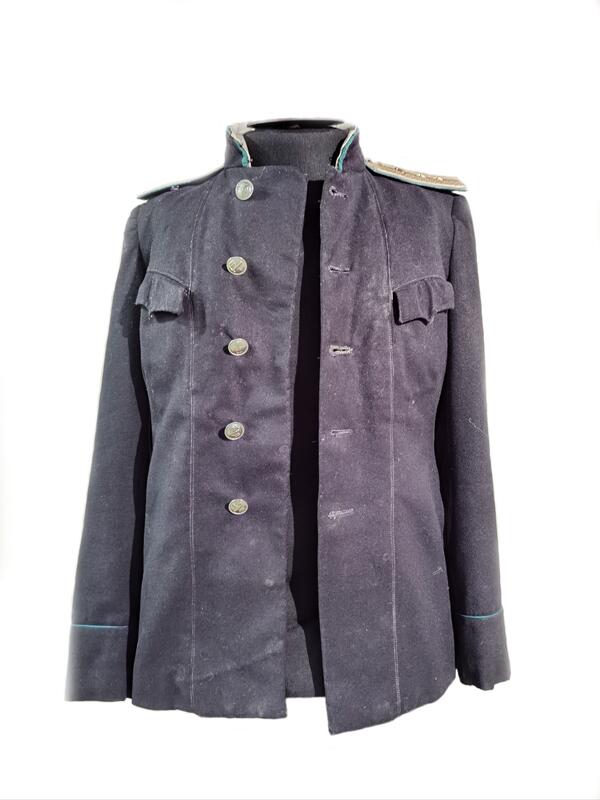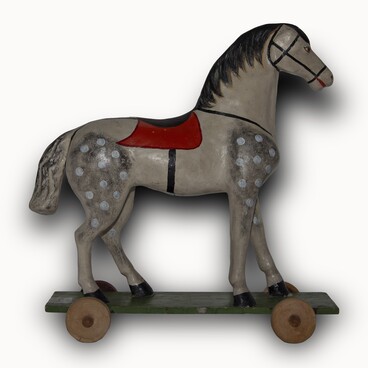Until 1950, the uniform of the Tyumen railway workers was similar to that of the military and police. Its main element was a single-breasted dark blue tunic with five black (blued) buttons. The tunic had two flap pockets on the chest and a turn-down collar with insignia sewn onto it according to the army standards.
This tunic belonged to Mikhail Nikolayevich Kovyazin who was a senior train driver of the Tyumen railway depot and a lieutenant engineer of the wagon line, as evidenced by the locomotives that are depicted on the shoulder marks. He was awarded the title of an honorary railwayman twice and the Order of the Red Banner of Labor. He worked as a train driver at the Tyumen depot between 1938 and 1968.
During the difficult period of the Great Patriotic War, Mikhail Kovyazin’s crew worked hard on the legendary frontline locomotive, which now stands on a pedestal in the Semyon Patsko Garden Square. It joined the Tyumen locomotive depot in the fall of 1941. Steam locomotive series FD 21 No. 3031 (named after Felix Dzerzhinsky) arrived in Tyumen under its own power straight from the Leningrad Front.
There were indentations from shelling and bombing on its rusty hull, the boiler was broken in several places, and the insulation was almost completely destroyed. Repairmen restored the train and gave it a “second youth”: such models were more powerful and, most importantly, faster compared to other trains. A Komsomol crew was formed in the depot for the “frontline train” which worked on it throughout the war under the leadership of the senior driver Mikhail Kovyazin.
The young crew quickly mastered the nuances of driving the locomotive, tested its power, and began to drive trains weighing almost three times the load rate — up to 5,600 tons. Later, other depot drivers followed the example of their colleagues.
For maintaining the locomotive in excellent technical state and trouble-free driving of trains, the driver Kovyazin and his colleagues repeatedly received awards and cash prizes from the management of the depot, the Tyumen branch of the Sverdlovsk Railway, and the national government. Their FD 21 No. 3031 was awarded the title of “The Best Steam Locomotive of the USSR Railroad Network” several times.
This tunic belonged to Mikhail Nikolayevich Kovyazin who was a senior train driver of the Tyumen railway depot and a lieutenant engineer of the wagon line, as evidenced by the locomotives that are depicted on the shoulder marks. He was awarded the title of an honorary railwayman twice and the Order of the Red Banner of Labor. He worked as a train driver at the Tyumen depot between 1938 and 1968.
During the difficult period of the Great Patriotic War, Mikhail Kovyazin’s crew worked hard on the legendary frontline locomotive, which now stands on a pedestal in the Semyon Patsko Garden Square. It joined the Tyumen locomotive depot in the fall of 1941. Steam locomotive series FD 21 No. 3031 (named after Felix Dzerzhinsky) arrived in Tyumen under its own power straight from the Leningrad Front.
There were indentations from shelling and bombing on its rusty hull, the boiler was broken in several places, and the insulation was almost completely destroyed. Repairmen restored the train and gave it a “second youth”: such models were more powerful and, most importantly, faster compared to other trains. A Komsomol crew was formed in the depot for the “frontline train” which worked on it throughout the war under the leadership of the senior driver Mikhail Kovyazin.
The young crew quickly mastered the nuances of driving the locomotive, tested its power, and began to drive trains weighing almost three times the load rate — up to 5,600 tons. Later, other depot drivers followed the example of their colleagues.
For maintaining the locomotive in excellent technical state and trouble-free driving of trains, the driver Kovyazin and his colleagues repeatedly received awards and cash prizes from the management of the depot, the Tyumen branch of the Sverdlovsk Railway, and the national government. Their FD 21 No. 3031 was awarded the title of “The Best Steam Locomotive of the USSR Railroad Network” several times.



